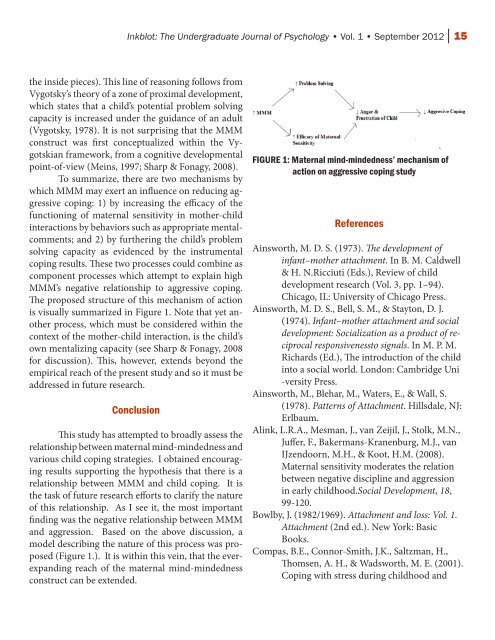7-17-Claire-Banga-Maternal-Mindedness
7-17-Claire-Banga-Maternal-Mindedness
7-17-Claire-Banga-Maternal-Mindedness
You also want an ePaper? Increase the reach of your titles
YUMPU automatically turns print PDFs into web optimized ePapers that Google loves.
Inkblot: The Undergraduate Journal of Psychology • Vol. 1 • September 2012 | 15<br />
the inside pieces). This line of reasoning follows from<br />
Vygotsky’s theory of a zone of proximal development,<br />
which states that a child’s potential problem solving<br />
capacity is increased under the guidance of an adult<br />
(Vygotsky, 1978). It is not surprising that the MMM<br />
construct was first conceptualized within the Vygotskian<br />
framework, from a cognitive developmental<br />
point-of-view (Meins, 1997; Sharp & Fonagy, 2008).<br />
To summarize, there are two mechanisms by<br />
which MMM may exert an influence on reducing aggressive<br />
coping: 1) by increasing the efficacy of the<br />
functioning of maternal sensitivity in mother-child<br />
interactions by behaviors such as appropriate mentalcomments;<br />
and 2) by furthering the child’s problem<br />
solving capacity as evidenced by the instrumental<br />
coping results. These two processes could combine as<br />
component processes which attempt to explain high<br />
MMM’s negative relationship to aggressive coping.<br />
The proposed structure of this mechanism of action<br />
is visually summarized in Figure 1. Note that yet another<br />
process, which must be considered within the<br />
context of the mother-child interaction, is the child’s<br />
own mentalizing capacity (see Sharp & Fonagy, 2008<br />
for discussion). This, however, extends beyond the<br />
empirical reach of the present study and so it must be<br />
addressed in future research.<br />
Conclusion<br />
This study has attempted to broadly assess the<br />
relationship between maternal mind-mindedness and<br />
various child coping strategies. I obtained encouraging<br />
results supporting the hypothesis that there is a<br />
relationship between MMM and child coping. It is<br />
the task of future research efforts to clarify the nature<br />
of this relationship. As I see it, the most important<br />
finding was the negative relationship between MMM<br />
and aggression. Based on the above discussion, a<br />
model describing the nature of this process was proposed<br />
(Figure 1.). It is within this vein, that the everexpanding<br />
reach of the maternal mind-mindedness<br />
construct can be extended.<br />
FIGURE 1: <strong>Maternal</strong> mind-mindedness’ mechanism of<br />
action on aggressive coping study<br />
References<br />
Ainsworth, M. D. S. (1973). The development of<br />
infant–mother attachment. In B. M. Caldwell<br />
& H. N.Ricciuti (Eds.), Review of child<br />
development research (Vol. 3, pp. 1–94).<br />
Chicago, IL: University of Chicago Press.<br />
Ainsworth, M. D. S., Bell, S. M., & Stayton, D. J.<br />
(1974). Infant–mother attachment and social<br />
development: Socialization as a product of re-<br />
ciprocal responsivenessto signals. In M. P. M.<br />
Richards (Ed.), The introduction of the child<br />
into a social world. London: Cambridge Uni<br />
-versity Press.<br />
Ainsworth, M., Blehar, M., Waters, E., & Wall, S.<br />
(1978). Patterns of Attachment. Hillsdale, NJ:<br />
Erlbaum.<br />
Alink, L.R.A., Mesman, J., van Zeijil, J., Stolk, M.N.,<br />
Juffer, F., Bakermans-Kranenburg, M.J., van<br />
IJzendoorn, M.H., & Koot, H.M. (2008).<br />
<strong>Maternal</strong> sensitivity moderates the relation<br />
between negative discipline and aggression<br />
in early childhood.Social Development, 18,<br />
99-120.<br />
Bowlby, J. (1982/1969). Attachment and loss: Vol. 1.<br />
Attachment (2nd ed.). New York: Basic<br />
Books.<br />
Compas, B.E., Connor-Smith, J.K., Saltzman, H.,<br />
Thomsen, A. H., & Wadsworth, M. E. (2001).<br />
Coping with stress during childhood and



